At its core, the Enneagram helps us to see ourselves at a deeper,
more objective level and can be of invaluable assistance
on our path to self-knowledge.
~Don Riso and Russ Hudson
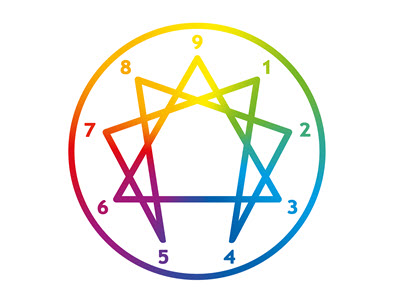 Discoverying your personality type
Discoverying your personality type
In all my years as a social worker and as a therapist in private practice, I have not found any personality system or typology as dynamic and as effective as the Enneagram (pronounced “ANY-a-gram”).
When I first became introduced to the Enneagram in the 1990s, it initially seemed like every other personality typology, and I could not see many benefits. There were so few resources about the Enneagram at that time, and I was personally struggling. I even mistyped myself!
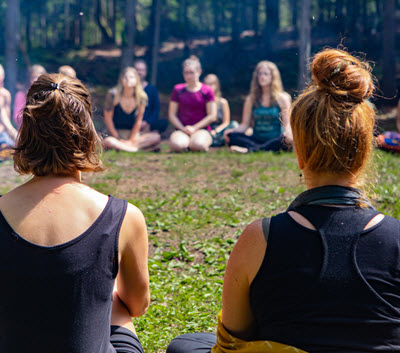 Gaining new insight into my relationship
Gaining new insight into my relationship
Fast forward to 2010, when my fiancé and I were attending a week-long musical and cultural retreat in the Michigan woods.
We were getting married in a few months after coupling for six years, and we had begun experiencing many of the same rubs other couples experience after all of the shininess of a new relationship wears off. More importantly, we were stuck in our ways of thinking and judging.
The Enneagram workshop was offered at the retreat, and we decided to attend in the hope that it provide more tools to help us to understand each other better.
With only a few handouts and a detailed flip chart, we were mesmerized!
Here in the middle of the woods, we were able to understand ourselves and each other more in 3 hours than after the previous six months of relationship therapy!
That says a lot because I am a marriage and family therapist and know a few things about relationship dynamics!
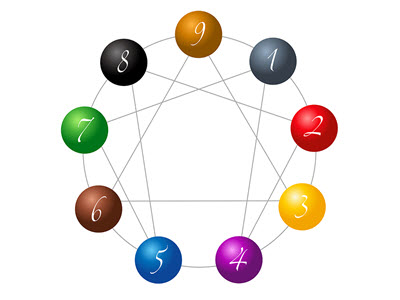 Why the Enneagram matters
Why the Enneagram matters
Sheila, the facilitator, not only was well-versed and knowledgeable but could deliver the information with humor, humility, and poise.
She also shared how dynamic the Enneagram is and how it can be not only a gateway to understanding ourselves and others but could also assist in quieting the inner critic living in each one of us.
She introduced me to the idea that the Enneagram was not about justifying our values and behaviors to ourselves and others, but that it could show us how believing these things about ourselves limit really figuring out who we are.
I could see that the Enneagram could be the bridge between Psychology and Spirituality, and it could be the key to ending much of my own suffering.
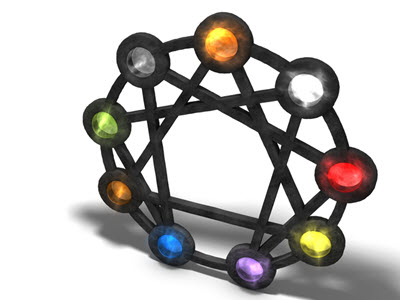 I would like to pass on the Enneagram wisdom to you.
I would like to pass on the Enneagram wisdom to you.
There is an old saying that, “When the student is ready, the teacher will appear.”
Since that retreat, I have become an active student in the Enneagram of self-discovery.
This has involved my participating in dozens of workshops and retreats all over the world.
Now, I am co-facilitating twice a year with a group of folks, who have made a commitment to themselves and each other to show up and be present, no matter how hard it seems at times.
The Enneagram has changed my life!
Understanding and working with the Enneagram has saved my marriage, helped me to truly love and accept myself and others as they are.
It has strengthened my ability as a therapist more than any other therapeutic technique I have learned.
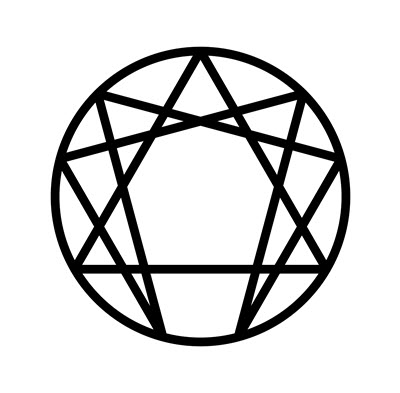 Brief bit of Enneagram history
Brief bit of Enneagram history
Enneagram is a Greek word that means nine (Ennea) and figure (Gram).
It is unknown exactly where and when the Enneagram originated; however, many scholars have connected the Enneagram to the three main religions, the Jewish Kabbalah, Christian Mysticism, and Sufism (a mystical form of Islam).
The Enneagram symbol
The Russian born and influential spiritual seeker, George Gurdjieff, reintroduced the Enneagram symbol in the middle east in the 1930s. He taught the meaning of the symbol by using sacred group movements to illustrate how our inner critic constricts us and limits our growth.
Although Gurdjieff never taught the Enneagram types, he did teach his students about each person’s ‘chief feature,’ which later became known as the main part of our personality structure (i.e., our ego or inner critic) that gets in the way of our true development.
Gurdjieff’s followers brought the symbol to the United States in the 1960s.
The Enneagram personality types
A Peruvian, Oscar Ichazo, also was a spiritual seeker and traveled all over South America and Asia. He began melding all of these teachings and learnings that he had acquired.
He formed a learning school in the 1950s and 1960s and began sharing this acquired knowledge of the personality types, their fears, and their vices with his students in Chile.
Ichazo brought all of this material together in a package, so people could begin to understand for themselves.
California psychologist, Claudio Naranjo, was one of his students and brought these teachings back to the United States in the 1960s.
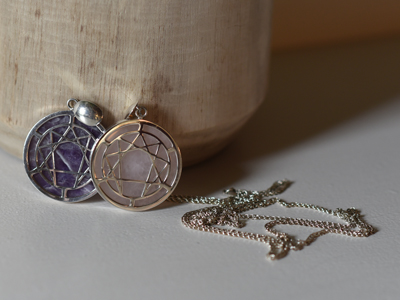 That is enough history for me. What exactly is the Enneagram?
That is enough history for me. What exactly is the Enneagram?
The basic premise of the Enneagram is that we are born with one of nine distinct personality types. There are variations to each type, similar to how there are different shades within the same color (i.e., lots of shades of blue), but there are nine distinct core motivations.
It is unknown how or when our personality type becomes established in us, but unlike hair or eye color, there is no predisposition to be born with anyone’s distinct type. In other words, you could have eight other siblings, and each of them could be a different type from you, or all of you could be the same type.
Even mothers, who have been pregnant with more than one child, report that the temperament of each child felt different in the womb just as after the child was born.
Also, no one personality type is better or worse than another type. Type 9 is not ‘better’ than Type 1.
We each have a distinct Enneagram type.
Although we can identify with each type and experience each type in us, there is one type that will ultimately resonate.
Each type (noted by a number along the Enneagram Symbol) has unique wishes and desires, a unique primal fear, and each type has distinctive, coping patterns that we lean on when we feel great or when we are under stress.
The Enneagram does not put us in a box, it shows us the box we are already in—and the way out.
~Riso & Hudson
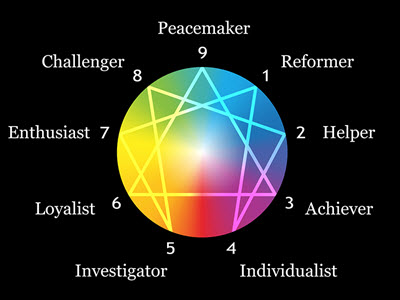 Brief Description of the 9 Enneagram Types
Brief Description of the 9 Enneagram Types
Here is a diagram naming the 9 Types
In brief and taken from the Enneagram Institute website, here are a few descriptors and traits of each type.
Type One Reformer is principled, purposeful, self-controlled, and perfectionistic.
Type Two Helper is generous, demonstrative, people-pleasing, and possessive.
Type Three Achiever is adaptable, excelling, driven, and image-conscious.
Type Four Individualist is expressive, dramatic, self-absorbed, and temperamental.
Type Five Investigator is perceptive, innovative, secretive, and isolated.
Type Six Loyalist is engaging, responsible, anxious, and suspicious.
Type Seven Enthusiast is spontaneous, versatile, acquisitive, and scattered.
Type Eight Challenger is self-confident, decisive, willful, and confrontational.
Type Nine Peacemaker is receptive, reassuring, complacent, and resigned.
Is your curiosity piqued?
How do I learn about my Enneagram type?
There are many books and resources that help you begin to learn about the Enneagram. My favorite beginner book is Wisdom of the Enneagram by Don Riso and Russ Hudson.
There are short checklists for each type in the Wisdom book, so you can begin to narrow down which type you may be.
In addition, the website www.enneagraminstitute.com has a scientifically validated and quite accurate test that you can take online for $12.
You receive a score for each of the nine types at the end of the test, so you can see the 2 or 3 highest scores and begin to research the types for which you are most resonating.
Everyone wants insight into others; few people are as willing to look so intently at themselves.
~Don Richard Riso
Do I have to know my Enneagram type to work with you?
Nope! We can begin with your concerns and your struggles and later can reference how some self-knowledge can help you find more resolve and more peace.
How can MY understanding of the Enneagram help YOU?
For many years as a psychotherapist, I was trained to bond with clients, maintain healthy professional relationships, and learn very helpful techniques, strategies, and important theories that could assist them.
Although each technique that I implemented with clients always seemed to have some degree of success, I realized only after learning the Enneagram that I saw everything through my Enneagram type.
I was missing the core of my client’s suffering, often because I didn’t have that experience or specifically that type of suffering.
For example, if a client were afraid of bringing up their needs to their spouse, I would work with them on strategies instead of acknowledging the root of why they felt that way. Because I did not struggle with bringing up needs in my relationship, I incorrectly believed that the client just needed some tips or strategies.
 I was coming up short in helping my clients because I was getting in the way.
I was coming up short in helping my clients because I was getting in the way.
Think of it this way. If you are a specific type and see the world through red glasses, but your spouse (or your boss or your child) is another type and wears blue glasses, how can you truly see their perspective?
How can you begin to understand the Who, Why, and What that motivates the other person?
How can they begin to see your values and motivations?
Most of the time, it is an emotional or energetic tug of war, with each of us trying to justify our side and pull the other person closer to us. OUR perspective seems more appropriate or superior to theirs.
The Enneagram and conflict
This difference in personal conflict resolution styles happens when we experience conflict with another person or organization.
Depending on our personality type, we either assertively deal with it, withdraw from it, or take a roundabout way to get our needs met.
Telling someone, who withdraws from conflict to become more assertive, is just not going to cut it.
Truly understanding someone else’s fears and motivations and working with them to see the benefits of utilizing these other strategies allow them the space to feel safe and grow at the same time.
I cannot tell you how many people show up in therapy with these statements, such as “Nobody gets me,” “they never see what is important to me,” “I feel like I am not even seen,” and ”I don’t fit in.”
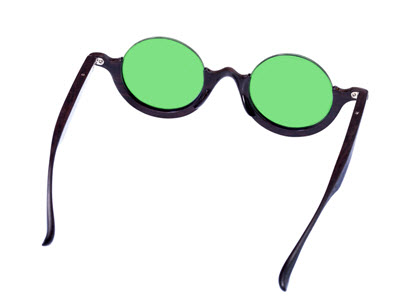 From seeing only green to seeing all of the colors of the rainbow
From seeing only green to seeing all of the colors of the rainbow
As a person and a therapist that saw the world through green glasses, EVERY theory and technique, let alone every conversation I had with my clients (or my family), was always tinged in green.
As you may realize, the problem was that I was talking and seeing everyone through my green lenses, while most of my clients wore lenses of different colors.
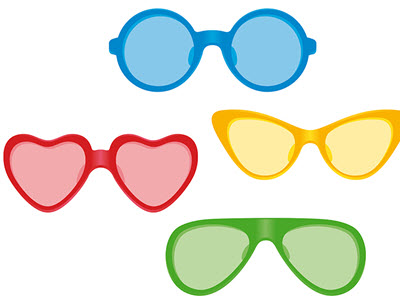 There is a better way.
There is a better way.
Once I began learning the motivations and fears of each of the types and the shades of each color, I began to listen for clues as to what type they may be and began to communicate in the color tint of each client’s glasses rather than my own.
It was like learning eight new languages and becoming multilingual.
Immediately, clients began sharing with me things like, “Oh my gosh! You sound like you have read my diary!’ or “How did you know that was what I was thinking?”
Couples began asking me to translate their perspectives (as if I was an actual multilingual translator) until they could learn each other’s differences without being fueled by anger or rejection.
Clients, who were struggling with how to deal with their teenagers, sister, father-in-law, or boss, were gaining insight about the ‘color of other people’s glasses.’
The Ah-ha moment is when you finally realize and see someone else’s perspective. You realize that “Wow. This is how they are. They are not going to change, so I need to change the way I experience them, so I am not as stressed or suffering. Kris, please help me to do that.”
More help for you sooner
Once I had learned these eight other ‘languages,’ the amount of time to get to know a new client shortened by 3-6 months, and clients began feeling seen and heard with the first initial phone call!
When we can give up the idea that there is something we are supposed to be, we can start to fall in love with the one that is here now.
~Russ Hudson

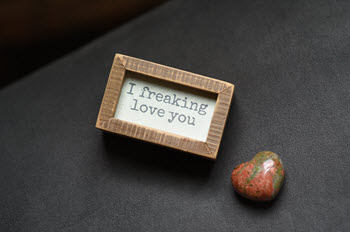 Are you ready to find and love the ‘real’ you?
Are you ready to find and love the ‘real’ you?
Satisfy it by either ‘doing all the right things’ or escaping in pleasure-seeking activities to avoid that restless feeling (or both).
What we are seeking is to know who we are and why we are here.
That feeling is difficult to define, and yet, when we begin to listen to it, we can find that it leads us on the most amazing journeys.
Are you ready to begin an amazing journey of self-discovery?
If the answer is yes, I will invite you to call me and schedule an initial hour consultation session. It is complementary, and we will begin to get yourself reacquainted with the real you.

